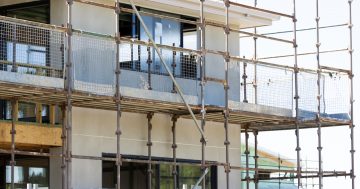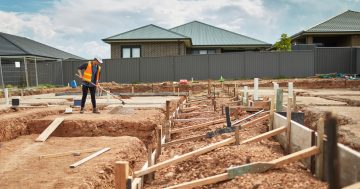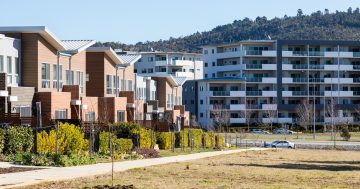
Townhouses in Coombs. Canberra needs more, says Master Builders ACT. Photo: Michelle Kroll.
Canberra’s single-block residential suburbs should be opened up for medium-density housing under the new planning system, according to Master Builders ACT.
In its submission on the draft Territory Plan proposed for the ACT’s new outcomes-based planning system, the building industry group said more private, public and community-owned duplexes, terrace-houses and townhouses could be built if current RZ1 areas were rezoned to the RZ2 standard.
It also calls for RZ2 areas to be rezoned to RZ3 and to allow more terrace-housing and low-rise apartment buildings that would rejuvenate local centres.
Reforming the CZ4 local centre zone would also enable apartments above shops, including increasing building heights to at least three storeys and reserving ground floor space for commercial space.
At the very least, Master Builders ACT said the dual occupancy arrangements for Mr Fluffy blocks purchased through the Asbestos Buyback Scheme should be applied generally, including not having to pay additional lease variation charges.
It also backs dual occupancies in RZ1 zones being separately titled.
Master Builders ACT wants to see fewer restrictions on the number of homes that can be built on a block, calling for the proposed 50 per cent plot ratio limitation in the RZ1 and RZ2 zones to be increased so “scarce land with this zoning” can achieve “optimal residential yield”.
The submission said that the ACT’s acknowledged housing crisis would not be eased without a combination of accelerating new land release and amendments to the Territory Plan to allow additional housing options in the residential zones.
“Unless the ACT intends to continuously sprawl to the NSW boundary, the RZ1 zone must be unlocked to accommodate housing for key workers, our aging population and natural population growth,” Master Builders CEO Michael Hopkins said.

MBA ACT CEO Michael Hopkins: more housing options needed in Canberra’s residential zones. Photo: Region.
The submission also wants mandatory parking requirements reduced to one car space per home across all residential zones to enable more sustainable housing designs and reduced housing costs for the increasing number of Canberra families who don’t own a car or only own one car.
It said storey limits should be scrapped in favour of an overall height limit in metres which would alleviate the need to regulate the height of basements.
Alarmed at the number of housing developments that end up in the ACT Civil and Administrative Appeals Tribunal, the submission calls for the removal of all third-party appeal rights for residential uses proposed in residential zones.
It said the new Territory Plan and the other components of the reform process should be supported by an Infrastructure Plan.
“If additional growth is allowed in established suburbs, in line with existing ACT Government policy, then we believe it is critical that the ACT Government also release a long-term infrastructure plan demonstrating to the community and industry where new infrastructure will be built to support this growth,” Mr Hopkins said.
He said the new planning system will need a boost to resources and training in the Environment, Planning and Sustainable Development Directorate to achieve what it proposes.
“The adoption of an outcomes-focused planning system will be a game changer for the Territory and, if implemented properly, it should allow for innovative proposals from the private sector,” Mr Hopkins said.
“However, this potential will not be delivered unless an injection of resources is provided to the development assessment teams across Government, especially design and architectural skills.”





















